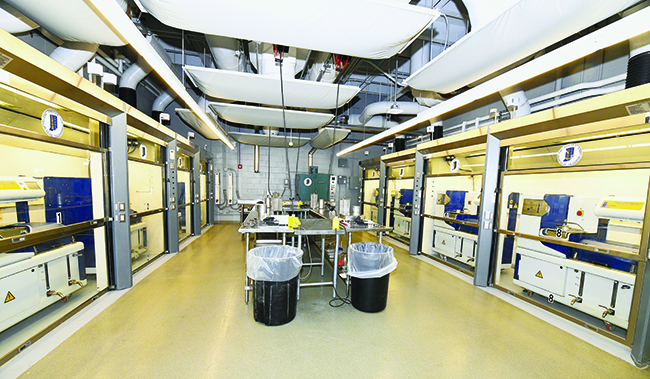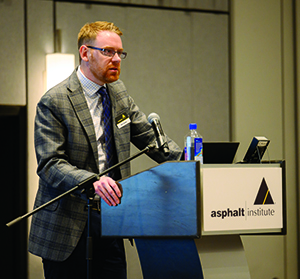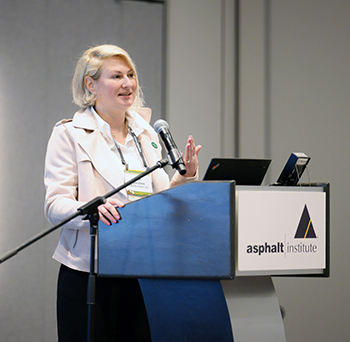Future options for asphalt labs without TCE
A typical day during the busy part of the season sees between 25 and 30 extractions per day. On our busiest day in 2024, the lab performed 53 extractions,” responded Matt Beeson, Director of the Division of Materials and Tests with the Indiana Department of Transportation, when asked how many asphalt extraction tests they typically perform in a day.
To accomplish this testing load, INDOT’s central lab currently operates ten auto extractors, with eight of them running the bulk of the testing demand in the acceptance lab. In 2024, INDOT performed just over 2,500 extractions.
Beeson stressed that auto extractors are key to INDOT’s efficiency and prioritization of worker safety. “Prior to auto extractors, we utilized centrifuge extractors, which is a manual process. We utilized them under fume hoods, but using a centrifuge still involved a lot more worker exposure to TCE. So, the main reason we chose to invest in auto extractors is worker safety. The more you can reduce exposure to TCE, the better. Additionally, moving from centrifuge extraction to the automatic units freed up technician time to perform other tasks while the units are running,” Beeson said.
Again, efficiency is the key. What was the chemical used for every single one of these tests? It was TCE, trichloroethylene, a commonly used solvent historically in our asphalt labs and one now with a limited future.
The Environmental Protection Agency (EPA) proposed a rule back in 2023 to prohibit the production and use of TCE in many industrial applications, including asphalt testing. After a period of comment review and discussion, the EPA published its final rule in December 2024.
To alleviate issues with immediately banning TCE from asphalt labs, a phase-out period has been identified: 5 years for open systems (this would include centrifuges and reflux systems) and 10 years for closed systems (this would include auto extractors). However, those organizations continuing to use TCE during this phase-out period are going to be required to monitor and document procedures on training employees and establishing a Workplace Chemical Protection Program (WCPP). This plan will need to include both dermal and respiratory protection.
The EPA has published “A Guide to Complying with the 2024 Trichloroethylene (TCE) Regulation Under the Toxic Substances Control Act (TSCA)” to provide compliance guidance with the new rules. The document is available for download at epa.gov. As with many regulations currently navigating through the federal government system, this topic, too, is subject to changing implementation dates. Please refer to the latest EPA guidance for the latest information.
Beeson added, “We have seen a reduction in binder content variability and improvement in repeatability since switching to TCE and auto extractors, so having to switch to a different solvent and centrifuge will reduce the quality of our testing. Also, all solvents have safety concerns, and returning to centrifuges will increase technician exposure.”
What options do our asphalt labs have to address both the rulemaking directives and address some of the concerns? Wes Cooper, Laboratory Manager and Senior Research Scientist with the Asphalt Institute, and Ann Baranov, Managing Director with infraTest USA, Inc., agreed to share their experiences and insights with asphalt lab personnel to help them better understand what options are or will be available.
Question: Aside from using TCE in auto extractors, what asphalt tests come to mind that allow or require the use of TCE?
Answer: (Cooper) TCE is still the primary solvent used for ensuring that an asphalt binder is relatively free of non-organic mineral matter. The two most common test methods for this type of determination (often referred to as the “Solubility Test”) are AASHTO T 44 (Solubility of Bituminous Materials) and ASTM D2042 (Standard Test Method for Solubility of Asphalt Materials in Trichloroethylene or Toluene). AASHTO T 44 lists TCE or trichloroethane (TCA) as the allowable solvents, while ASTM D2042 permits both TCE and toluene. Of the two test methods, AASHTO T 44 is the most widely used in the United States but is the most restrictive in that it only allows for the use of chlorinated solvents.
Question: The solubility test is being replaced in many specifications by the ash content test. Do you have any thoughts or guidance on how those two tests compare?
Answer: (Cooper) In 2016, AASHTO T111 (Standard Method of Test for Mineral Matter or Ash in Asphalt Materials), commonly referred to as the “Ash Test”, began to replace solubility testing in AASHTO specifications for anionic, cationic and polymer-modified asphalt emulsions. ASTM emulsified asphalt specifications followed suit in 2020, allowing for the use of either D2042 or D8078 (Standard Test Method for Ash Content of Asphalt Binder and Emulsified Asphalt Residues). A primary reason for this change was to eliminate testing difficulties related to polymer-modified residues. For example, latex-modified residues are known to “gel” on the crucible during solubility testing, plugging the filter pad and making the test procedure difficult or even impossible to perform.
Like solubility testing, the Ash Test is meant to ensure that paving binders and emulsified asphalt residues are relatively free of mineral matter. Whereas the Solubility Test involves dissolving organic matter with a solvent, the Ash Test uses a muffle furnace to incinerate all organic material, leaving behind a percentage of inorganic mineral matter. The Ash Test procedure accommodates more complex binders while removing the risks associated with the use of chlorinated solvents.
At the 2025 Asphalt Institute Spring Meeting, we presented a small data set showing that the Ash Test produces comparable results for unmodified binders and standard modified binders (in this case, a PG 64-22 and a PG 76-22/64E-22). In that same study, we also examined a highly modified asphalt (Hi-Mod) and found that the Ash Test did a better job of measuring mineral matter for larger polymer loads than the standard Solubility Test using TCE and toluene. So, there is an argument to be made for the Ash Test to be a viable (or even better) alternative to solubility testing for paving-grade binders.
Question: Manual extraction units are still quite common in our industry, including in our research lab. What steps did the Asphalt Institute take to replace TCE in manual extractions and what practice do you currently use?
Answer: (Cooper) We currently use ASTM D2172 (Standard Test Methods for Quantitative Extraction of Asphalt Binder from Asphalt Mixtures) and ASTM D7906 (Standard Practice for Recovery of Asphalt Binder from Solution Using Toluene and the Rotary Evaporator) for extraction and recovery of binder from hot-mix asphalt samples and asphalt shingles. We made the switch from TCE to toluene in the early 2010s, primarily from a safety/health standpoint, but also in the belief that less solvent aging of the recovered binder occurs from the use of toluene as compared to TCE. With some small adjustments to our setup, the change was easily implementable. However, the flash point of toluene is notably lower than TCE; thus, we needed to ensure that our storage and handling procedures were updated, and engineering controls were put in place to mitigate any fire risk.
Question: Did the Asphalt Institute team realize any efficiency or accuracy issues after making the switch to toluene?
Answer: (Cooper) Overall, the transition was reasonably seamless. From the standpoint of efficiency of recovered asphalt binder content, we did not see any notable difference in the switch from TCE to toluene. We did notice that binders recovered using toluene proved to be a bit softer than those recovered with TCE, quite possibly due to the lack of solvent hardening typically seen with TCE. Because this phenomenon was already well known, it was not an unexpected trend, and we were able to account for it in any subsequent testing or research.
Question: There are still labs that use TCE for cleaning purposes like removing asphalt residue from the DSR device and molds. What recommendations do you have for labs that still use TCE for this purpose?
Answer: (Cooper) In short: stop using TCE to clean your lab. There is no arguing the high effectiveness of TCE as a cleaning agent, but its hazards are well known, especially outside of a fume hood. There are too many safe and effective alternatives for asphalt labs to continue to use TCE as a cleaning agent.
At our laboratory in Lexington, we’ve found that a miscible solvent (such as mineral spirits or bio-based orange cleaner) can be used to handle most cleaning jobs. We recommend using a volatile solvent (like acetone or rubbing alcohol) to remove residues left behind by the miscible solvent. For cleaning DSRs, heat is your friend: elevating the temperature of the plates to 90-100°C makes cleaning much easier. Likewise, acetone can easily remove leftover asphalt residues on silicone DSR molds.
Question: Do you have any additional feedback to share?
Answer: (Cooper) The bottom line is that laboratory staff need to be educated on the risks associated with the use of any of these products, whether they are associated with long-term exposure hazards (TCE) or acute concerns (toluene). It’s vital that the appropriate engineering controls are put in place to reduce risks, and that proper personal protective equipment (PPE) is available to all laboratory staff. A culture of safety where employees are properly and regularly trained, and risks are taken seriously, will go a long way to creating a safer environment no matter which direction is chosen.
Additionally, we had the opportunity to interview Ann Baranov with questions specific to auto-extractors.
Question: For labs with an auto extractor, what other chemical options are available instead of TCE?
Answer: (Baranov) The automated extraction units are compatible with three chlorinated solvent types: Trichloroethylene (TCE) is the most popular, Methylene chloride (DCM) and Tetrachloroethylene (PCE) are the other options. We are working on exploring compatibility with some other types of non-hazmat solvents, but this will take some time.
Question: For those unfamiliar with the auto extractors, why can’t a lab use the chemicals available for manual extraction methods like toluene or n-Propyl bromide?
Answer: (Baranov) Since auto extractors operate in a closed loop system – pressurized under vacuum they are not compatible with highly flammable solvents like Toluene which has a flash point of (40F/4.4C). N-Propyl bromide is also classified as a hazardous solvent and has been banned in the EU for use in cleaning and degreasing processes under the REACH regulations, with a sunset date of July 4, 2020. Since the manufacturers of all the auto extraction units are EU based, it’s not a solvent that we can test with during manufacturing process, plus the solvent is less effective than chlorinated ones so it’s not as popular.
Question: With PCE being an option moving forward, do AASHTO and ASTM specifications allow this material currently as an option?
Answer: (Baranov) Both ASTM and AASHTO committees have begun balloting the addition of PCE solvent to both extraction and recovery standards. This is a process that will likely take 1-2 years to finalize.
Question: How do extraction and recovery data compare using PCE and TCE?
Answer: (Baranov) PCE is a solvent that is very common in asphalt testing in South America and Europe. When Germany phased out TCE in 2023 after a similar 10-year phase-out the industry converted all their automated extraction units to work with PCE. PCE is allowed as part of the EN 12697‑3. We are currently waiting for more data from the South American labs.
Question: Does using PCE require more time for a sample to be extracted as compared to TCE?
Answer: (Baranov) No, performance using both solvents is the same with regards to time and solvent quantity required to get successful results.
Question: Since many European countries have switched to PCE, what challenges did their labs have in making the switch?
Answer: (Baranov) The only challenge was in setting up the technical service visit to perform the change of solvents. This must be done by an authorized and trained service provider so planning in advance and not waiting until the 10-year phase out is a good idea.
Question: Any perspective on changes in cost and availability of PCE compared to TCE?
Answer: (Baranov) Overall, while both chemicals face restrictions, TCE is likely to become less available and potentially more expensive compared to PCE in the near future due to more immediate and comprehensive bans on its use. Despite regulations, the TCE market is still projected to grow from $412 million in 2024 to $508 million by 2030, at a CAGR (Compound Annual Growth Rate) of 3.5%. This suggests ongoing demand may keep prices relatively stable in the short term.
Question: Many labs recover TCE in reclamation units; will PCE be able to be recovered in an equivalent way?
Answer: (Baranov) Yes! PCE is compatible with reclamation units that are using TCE. You may need to adjust temperature settings in these units to accommodate the higher boiling point of PCE.
Question: What are the current requirements for labs using PCE to meet the PCE rulemaking currently in effect?
Answer: (Baranov) Current OSHA Standards for PCE which are still in effect in the workplace are 100 parts per million (ppm) per 8-hour time-weight average (TWA). PCE was proposed as a replacement for TCE by EPA in asphalt testing with the same WCPP requirements and new stricter exposure limits as for TCE. The timeline for compliance is longer than for TCE and is also currently on hold under review by the current administration. The new EPA proposed exposure limit for PCE is 0.14 ppm per 8-hour TWA. To ensure compliance with these strict limits additional engineering controls like snorkel vents or walk-in hoods as well as good quality PPE are highly recommended.
Question: Do you have any additional thoughts you would like to share?
Answer: (Baranov) Although the new regulations around TCE and PCE and DCM seem strict, and the exposure limits are significantly higher than those currently accepted by OSHA, this is a step in the right direction for our industry. We want all workers to feel safe and protected when doing their job. With the technology available today, like the automated closed system extraction units, walk-in hoods, snorkel vents and high-quality PPE, we are able to ensure safety without compromising the quality of the work we do in the lab. Solvent vapor monitoring sensors and gauges are readily available and should be in every lab using solvents to ascertain that exposure limits are met and everyone is safe. Training is still the key to safety and providing additional training is essential to maintaining safety when using solvents.
Moving forward
So, what comes next for asphalt testing labs like INDOT’s? Beeson shared that when the original rulemaking was introduced, “We considered the use of other solvents, and even returning to ignition oven. However, we would still need to do extractions to validate ignition oven calibration samples, making that option undesirable and a bit pointless.”
Beeson shared INDOT’s future plans: “We are planning to move to PCE in a future construction season. Our auto extractor units can be converted to use PCE with a software update.” With any change, there is a period of questions and answers. Beeson added, “We have no experience using PCE as an extraction solvent. How will it perform compared to TCE? Are there other safety concerns we need to know about that differ from TCE?”
These are the questions that INDOT and others in our industry will answer in time as we all transition away from TCE.
Wielinski is an Asphalt Institute Regional Engineer based in Ohio.

















